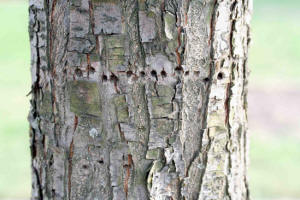|
 Lawn spots, tree holes, slow-moving equipment Lawn spots, tree holes, slow-moving equipment
By John
Fulton
 Send a link to a friend
Send a link to a friend
[September 15, 2010]
There are many dead spots in lawns, and
there will be more in a short time. Many spots have been present
since midsummer and were due to fungi killing the grass. As a simple
review, it is not recommended to treat a fungus in home lawns due to
the cost, frequency and potential allergic reaction of people and
pets. In some cases, the extremely wet weather followed by hot, dry
conditions actually killed portions of lawns. The third possible
problem is grub damage. There have been reports of high numbers of
grubs in spots within a yard and along edges of driveways and
sidewalks.
|
 As for what to do, the grub problem would need to be treated.
Japanese beetle grubs should have all hatched out by now, so
controls would be effective. Traditional grub treatments and carbaryl (Sevin) are effective on Japanese beetle grubs. The
carbaryl is not effective on other types of grubs. After grub
treatment, and to deal with the other causes of dead grass
spots, get new seed down quickly. We are actually beyond the
suggested dates to put down new seed, but the odds for seeding
success are generally better in the fall. As for what to do, the grub problem would need to be treated.
Japanese beetle grubs should have all hatched out by now, so
controls would be effective. Traditional grub treatments and carbaryl (Sevin) are effective on Japanese beetle grubs. The
carbaryl is not effective on other types of grubs. After grub
treatment, and to deal with the other causes of dead grass
spots, get new seed down quickly. We are actually beyond the
suggested dates to put down new seed, but the odds for seeding
success are generally better in the fall.Holes in trees
Many people are reporting holes in trees. These holes are
round and in a pattern either around or up and down on tree
trunks. They are also usually found in a tree that has high sap
flows, such as maples, gums or evergreens. These holes are
caused by yellow-bellied sapsuckers. The holes can cause injury
to trees by allowing a place for insects and disease to get in
and can kill a tree if the holes completely girdle it.

About the time we notice the holes, the birds are gone. They
migrate and only bless us with their presence about two months
in the spring (around May) and again in the fall (around
September). Sapsuckers are migrating through the area now and
will remain with us until their instincts tell them to head
farther south.
Control is very difficult and consists of trying to scare the
birds with pie pans, whirlybirds, rubber snakes or other items
that make sound or sight.
If damage in an area of the tree trunk is severe, you can
wrap burlap around that portion to protect it. The sticky-type
products, such as Tanglefoot, would also have some effect but
might cause problems for some of the non-sapsuckers in the area.
[to top of second column] |
 Several others causes for holes do exist. Other than sapsuckers,
the main causes lately have been borers and carpenter ants.
Carpenter ants are the large, black ants that are very
noticeable. They get their name from where they lay their eggs --
meaning that the female chews holes in wood to make a nesting
galley. The damage from the carpenter ant is not of the same degree
as termites. Termites digest the wood fiber and structurally weaken
it, while the carpenter ants make holes in the wood and don't weaken
it. The bad news is that carpenter ants like to nest in dead wood.
If you have ant activity in a tree, odds are that there is some dead
wood in the tree.
You can help the situation with secondary insects such as
carpenter ants by painting exposed wood with exterior latex paint or
spraying with an insecticide that has some residual. Current choices
would be bifenthrin or permethrin.
Harvest season
The fall harvest and farming season has begun in earnest.
Remember to use caution around the slow-moving equipment. A speed of
20 mph will be about the highest you will see on roadways from
tractors. Farm equipment is also large and heavy. Be patient and
exercise caution when farm equipment is on the road. We all need to
share the roadway, so let's do it safely.
[By
JOHN FULTON,
University of Illinois Extension, Logan County]
 |